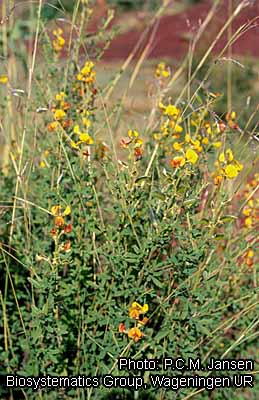Crotalaria natalitia (PROTA)
Introduction |
| General importance | |
| Geographic coverage Africa | |
| Geographic coverage World | |
| Medicinal | |
| Ornamental | |
| Auxiliary plant | |
Crotalaria natalitia Meisn.
- Protologue: London Journ. Bot. 2: 67 (1843).
- Family: Papilionaceae (Leguminosae - Papilionoideae, Fabaceae)
- Chromosome number: 2n = 16
Vernacular names
- Rattlepod (En).
- Crotalaire (Fr).
- Marejea (Sw).
Origin and geographic distribution
Crotalaria natalitia occurs widely in East and southern Africa. In Central Africa it is restricted to Burundi and the extreme east of DR Congo. It is also found in Yemen.
Uses
The tender leaves of Crotalaria natalitia are used as a vegetable in Tanzania and Malawi. In Malawi fresh leaves and flowers are cooked with potash, giving a mucilaginous product. In Tanzania the fresh leaves are used, as well as pounded and dried leaves. People add groundnuts or coconut milk to make the dish more palatable.
In Tanzania Crotalaria natalitia is also used as an ornamental and as a green manure. The bark from fresh roots is chewed, and the juice swallowed as a treatment for boils. After several days the boils ripen, can be cut and squeezed out.
Description
- Perennial herb or small shrub up to 2.5 m tall; branches usually ascending, with short appressed to slightly spreading hairs.
- Leaves mostly in tufts, 3-foliolate; stipules asymmetrical, 0.5–1.5 cm long; petiole slightly shorter than leaflets; leaflets oblanceolate-linear to oblanceolate-elliptical, (1.5–)2–4.5 cm × 0.4–1.5 cm, appressed pubescent below.
- Inflorescence a terminal raceme up to 22 cm long, few- to many-flowered; bracts linear to elliptical-caudate, 2.5–6 mm long.
- Flowers bisexual, zygomorphic, 5-merous; calyx 6–10 mm long; corolla yellow, with ovate or elliptical standard tinged reddish brown, wings longer than keel, keel with a short incurved beak, up to 1.5 cm long; stamens 10, all joined in a sheath open at base.
- Fruit a broadly cylindrical, inflated pod 3.5–4.5 cm × 1–1.5 cm, glabrous, many-seeded.
- Seeds oblong-reniform, up to 4 mm long, smooth, dark brown.
Crotalaria comprises about 600 species and occurs throughout the tropics. Africa is by far richest with approximately 500 species. The more important leaf vegetables in the genus are Crotalaria brevidens Benth. and Crotalaria ochroleuca G.Don. Crotalaria spp. are often difficult to distinguish and may have been confused in the literature.
Ecology
Crotalaria natalitia occurs in the plateau regions of East Africa and Angola in a variety of moderately open habitats such as grassland, forest edges and roadsides, up to 3000 m altitude. It descends to sea-level along the east coast of Africa.
Management
In Tanzania Crotalaria natalitia is traded on local markets.
Genetic resources
Crotalaria natalitia is not threatened by genetic erosion because it is widely distributed and fairly common.
Prospects
Crotalaria natalitia is a vegetable of local importance, and will likely remain so.
Major references
- Burkill, H.M., 1995. The useful plants of West Tropical Africa. 2nd Edition. Volume 3, Families J–L. Royal Botanic Gardens, Kew, Richmond, United Kingdom. 857 pp.
- Polhill, R.M., 1982. Crotalaria in Africa and Madagascar. A.A. Balkema, Rotterdam, Netherlands. 389 pp.
- Ruffo, C.K., Birnie, A. & Tengnäs, B., 2002. Edible wild plants of Tanzania. Technical Handbook No 27. Regional Land Management Unit/ SIDA, Nairobi, Kenya. 766 pp.
- Williamson, J., 1955. Useful plants of Nyasaland. The Government Printer, Zomba, Nyasaland. 168 pp.
Other references
- Kokwaro, J.O., 1993. Medicinal plants of East Africa. 2nd Edition. Kenya Literature Bureau, Nairobi, Kenya. 401 pp.
Author(s)
- C.H. Bosch, PROTA Network Office Europe, Wageningen University, P.O. Box 341, 6700 AH Wageningen, Netherlands
Correct citation of this article
Bosch, C.H., 2004. Crotalaria natalitia Meisn. [Internet] Record from PROTA4U. Grubben, G.J.H. & Denton, O.A. (Editors). PROTA (Plant Resources of Tropical Africa / Ressources végétales de l’Afrique tropicale), Wageningen, Netherlands.
Accessed 6 March 2025.

